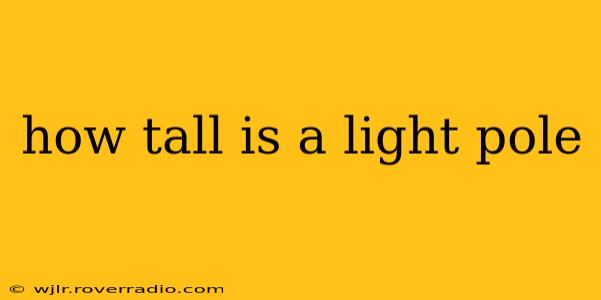How Tall Is a Light Pole? The Surprising Variability of Street Lighting
The simple question, "How tall is a light pole?" doesn't have a simple answer. The height of a light pole varies considerably depending on several factors. There's no one-size-fits-all answer, and understanding these variables is key to grasping the range of heights you might encounter.
What Determines the Height of a Light Pole?
Several factors influence the height of a light pole:
-
Location: Light poles in residential areas are typically shorter than those on highways or in parking lots. Residential areas might use poles around 10-15 feet tall, while highway lighting often requires poles of 25-40 feet or more to effectively illuminate a wide area. Consider the area around sports fields, which may require even taller poles to adequately light the playing surface.
-
Lighting Type: The type of lighting fixture used impacts pole height. High-pressure sodium (HPS) and metal halide (MH) lights, often used for broader illumination, might be mounted on taller poles. More modern LED lights, due to their efficiency and directional capabilities, can often achieve similar illumination at lower mounting heights.
-
Purpose: The intended purpose of the lighting dictates the necessary height. Streetlights designed for pedestrian safety might be lower than those intended for high-speed traffic visibility. Security lighting in parking garages will likely have different height requirements than those in a park.
-
Aesthetics: While functionality is paramount, aesthetics also play a role. In areas with historic architecture or specific design guidelines, light pole heights might be chosen to complement the surroundings.
How Tall Are Different Types of Light Poles?
While providing exact figures is impossible without specific context, here's a general overview:
- Residential Streetlights: Typically 10-15 feet tall.
- Streetlights on Major Roads: Often 25-40 feet tall, sometimes even taller.
- Highway Lighting: Can range from 30 feet to 50 feet or more, depending on traffic speed and road design.
- Sports Field Lighting: These can be exceptionally tall, often exceeding 50 feet to ensure adequate illumination of the playing field.
- Parking Lot Lighting: Heights vary greatly based on the size and layout of the parking lot, ranging from 15-30 feet.
What are the Different Types of Light Poles?
Beyond height, the material and design of light poles themselves varies significantly. Common types include:
- Steel Poles: These are very common and offer a balance of strength and cost-effectiveness.
- Aluminum Poles: Lighter than steel, aluminum poles are often favored in areas prone to high winds.
- Concrete Poles: Primarily used for very high-intensity lighting or in areas where strength and durability are paramount.
- Wooden Poles: Less common in modern street lighting, they are sometimes seen in more traditional or aesthetically driven settings.
How are Light Pole Heights Determined?
The selection of light pole height is a complex process involving engineers, lighting designers, and city planners. Factors like light distribution patterns, visibility requirements, and safety regulations all play a critical role. Detailed lighting studies are often conducted to optimize the height for the specific needs of the location.
In conclusion, the height of a light pole is highly variable and depends on a number of factors. There is no single answer to the question; instead, the height is determined by a range of factors to optimize both functionality and aesthetics.
